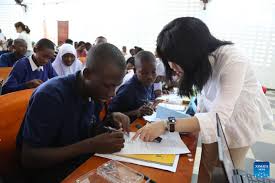Enhancing Conceptual Understanding in Mathematics: The Effectiveness of the Square Method for Computing Areas of Irregular Shapes Among Secondary School Students in Tanzania
Main Article Content
Abstract
This quantitative study investigates the effectiveness of the square method for teaching secondary school students to compute the area of irregular shapes, integrating mathematics and geography within the context of the school environment. Conducted at KIHONDA and MAFIGA Secondary Schools, the research involved 200 Form Four students selected through simple random sampling. Utilizing a pre-test and post-test design, data were collected to evaluate students’ understanding before and after engaging in practical learning activities. The intervention required students to identify irregular shapes, such as broken windows and cracked tiles, within their school environment, and to compute their area using the square method by counting full and partial squares on a grid overlay. The findings reveal significant improvements in students’ skills: recognition of irregular shapes increased from 22% in the pre-test to 86% in the post-test, indicating enhanced engagement with the material. Furthermore, students demonstrated a marked improvement in selecting appropriate measuring tools and applying estimation techniques. The use of visual aids and hands-on activities facilitated the development of spatial reasoning and provided students with a better grasp of geometric concepts in practical contexts. Group-based exercises further encouraged collaborative learning and problem-solving. Despite these positive outcomes, challenges were noted, including the time-consuming nature of the method when applied to large or complex shapes and a recognized need for additional training and resources among teachers. Overall, the study concludes that the square method is an effective pedagogical strategy for improving students’ understanding of irregular area computation, advocating for its integration across subjects to foster interdisciplinary learning. Future research is encouraged to explore the incorporation of digital tools to complement this method and assess long-term retention of concepts acquired through this approach.
Downloads
Article Details
Issue
Section

This work is licensed under a Creative Commons Attribution-NonCommercial-NoDerivatives 4.0 International License.
References
Adler, I., 1960. Mathematics: Exploring the world of numbers and space. Golden Press.
Babbie, E.R., 2020. The practice of social research. Cengage Learning.
Boaler, J., 2016. Mathematical mindsets: Unleashing students' potential through creative math. Jossey-Bass.
Boyles, N., Contadino, D., 1998. The learning differences sourcebook. McGraw Hill.
Bryman, A., 2016. Social research methods. Oxford University Press.
Charles, R .I., Lester, F.K., 2020. Teaching mathematics: Developing understanding through problem solving. Pearson Education.
Cherif, A., 2017. Connecting mathematics to real-life experiences: A dtudy on the relevance of geometry in students' lives. Mathematics Education Research Journal. 29(2), 5-32. doi:10.1007/s13394-016-0177-1. 2017.
Clements, D.H., Sarama, J., 2009. Visual spatial reasoning in mathematics.
Clements, D.H., Sarama, J., 2014. Learning and teaching early math: The learning trajectories approach. Routledge.
Creswell, J.W., Creswell, J.D., 2017. Research design: Qualitative, quantitative, and mixed methods approaches. SAGE Publications.
Creswell, J.W., Creswell, J.D., 2018. Research design: Qualitative, quantitative, and mixed methods approaches. SAGE Publications.
Harris, J., 2009. Area and perimeter of composite figures.
Kuzniak, A.M., Richard, P.R., 2018. Measuring irregular figures: A guide for students. Journal of Geometry and Education, 26(2), 45–58.
Mayer, R.E., 2009. Multimedia learning. Cambridge University Press.
National Council of Teachers of Mathematics., 2000. Principles and standards for school mathematics. NCTM.
National Council of Teachers of Mathematics., 2014. Principles to actions: Ensuring mathematical success for all. NCTM.
Neuman, W.L., 2014. Social research methods: Qualitative and quantitative approaches. Pearson Education.
Piaget, J., 1973. To Understand is to invent: The future of education. Grossman Publishers.
Reys, R., Lindquist, M.M., Lambdin, D., Smith, N.L ., 2012. Helping children learn mathematics. Wiley.
Schwab, J., 2017. Methods of area measurement.
Utley, J., Redmond, T., 2020. Geometry in the real world: Enhancing spatial skills through school-based exploration. Journal of Mathematics Education, 13(2), 87–95.
Van de Walle, J.Á.,Karp, K.S., Bay-Williams, J.M., 2019. Elementary and middle school mathematics: Teaching developmentally. Pearson.
Vygotsky, L.S., 1978. Mind in society: The development of higher psychological processes. Harvard University Press.

